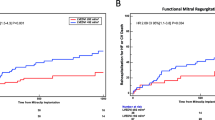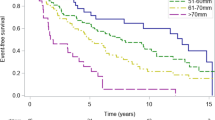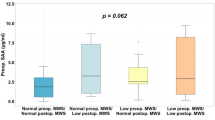Abstract
Background
Previous literature has demonstrated equivalent or improved survival post mitral valve (MV) surgery amongst patients with obesity when compared to their normal-weight counterparts. This relationship is poorly understood and the impact of body mass index (BMI) on cardiac remodeling has not been established.
Methods
In this retrospective, single-center study, we sought to identify the impact that BMI may have on long-term outcomes and cardiac remodeling post-MV repair. Outcomes were compared between patients of varying BMI undergoing MV repair between 2004 and 2018. The primary outcome was mortality and secondary outcomes included stroke, myocardial infarction, reoperation of the MV, rehospitalization, and cardiac remodeling.
Results
A total of 32 underweight, 249 normal weight, 249 overweight, 121 obese, and 50 morbidly obese patients were included in this study. Underweight patients had increased mortality at longest follow-up. Patients with morbid obesity were found to have higher rates of readmission for heart failure. Only underweight patients did not demonstrate a significant reduction in LVEF. Patients with normal weight and overweight had a significant reduction in left atrial size, and patients with obesity had a significant reduction in MV area.
Conclusions
An obesity paradox has been identified in cardiac surgery. While patients with obesity have higher rates of comorbidities preoperatively, their rates of mortality are equivalent or even superior to those with lower BMI. The results of our study confirm this finding with patients of high BMI undergoing MV repair demonstrating equivalent rates of morbidity to their normal BMI counterparts. While the obesity paradox has been relatively consistent in the literature, the understanding of its cause and long-term impacts are not well understood. Further focused investigation is necessary to elucidate the cause of this relationship.
This is a preview of subscription content, access via your institution
Access options
Subscribe to this journal
Receive 12 print issues and online access
$259.00 per year
only $21.58 per issue
Buy this article
- Purchase on Springer Link
- Instant access to full article PDF
Prices may be subject to local taxes which are calculated during checkout

Similar content being viewed by others
References
Nkomo VT, Gardin JM, Skelton TN, Gottdiener JS, Scott CG, Enriquez-Sarano M. Burden of valvular heart diseases: a population-based study. Lancet. 2006;368:1005–11.
Etzioni DA, Starnes VA. The epidemiology and economics of cardiothoracic surgery in the elderly. Cardiothoracic Surgery in the Elderly New York, NY: Springer New York; 2011. p. 5–24.
Benjamin EJ, Muntner P, Alonso A, Bittencourt MS, Callaway CW, Carson AP, et al. Heart disease and stroke statistics—2019 update: a report from the American Heart Association. Circulation. 2019;139:e56–66.
Chooi YC, Ding C, Magkos F. The epidemiology of obesity. Metab Clin Exp. 2019;92:6–10.
Poirier P, Giles TD, Bray GA, Hong Y, Stern JS, Pi-Sunyer FX, et al. Obesity and cardiovascular disease: pathophysiology, evaluation, and effect of weight loss. Arterioscler Thromb Vasc Biol. 2006;26:968–76.
Bozso SJ, Nagendran J, Gill RS, Freed DH, Nagendran J. Impact of obesity on heart and lung transplantation: does pre-transplant obesity affect outcomes? Transplant Proc. 2016;49:344–7.
Burns DJP, Rapetto F, Angelini GD, Benedetto U, Caputo M, Ciulli F, et al. Body mass index and early outcomes following mitral valve surgery for degenerative disease. J Thorac Cardiovasc. 2019;S0022-5223:33118–6.
Chen HY, Engert JC, Thanassoulis G. Risk factors for valvular calcification. Curr Opin Endocrinol Diabetes Obes. 2019;26:96–102.
Saliba LJ, Maffett S. Hypertensive heart disease and obesity: a review. Heart Fail Clin. 2019;15:509–17.
Mariscalco G, Wozniak M, Dawson A, Serraino G, Porter R, Nath M, et al. Body mass index and mortality among adults undergoing cardiac surgery: a nationwide study with a systematic review and meta-analysis. Circulation. 2017;135:850–63.
Reser D, Sündermann S, Grünenfelder J, Scherman J, Seifert B, Falk V, et al. Obesity should not deter a surgeon from selecting a minimally invasive approach for mitral valve surgery. Innovations. 2013;8:225–9.
Rapetto F, Bruno VD, King M, Benedetto U, Caputo M, Angelini GD, et al. Impact of body mass index on outcomes following mitral surgery: does an obesity paradox exist? Interact Cardiovasc Thorac Surg. 2018;26:590–5.
Ghanta RK, LaPar DJ, Zhang Q, Devarkonda V, Isbell JM, Yarboro LT, et al. J Am Heart Assoc. 2017;6:e003831.
Bruno VD, Chivasso P, Rapetto F, Guida G, Di Tommaso E, Chau HM, et al. Impact of body mass index on short- and long-term outcomes after isolated first-time surgical aortic valve replacement for aortic stenosis. J Cardiothorac Vasc Anesth. 2019;33:2995–3000.
Forgie K, Bozso SJ, Hong Y, Norris CM, Ishaque A, Gill RS, et al. The effects of body mass index on outcomes for patients undergoing surgical aortic valve replacement. BMC Cardiovasc Disor. 2020;20:255.
Nagendran J, Moore MD, Norris CM, Khani-Hanjani A, Graham MM, Freed DH, et al. The varying effects of obesity and morbid obesity on outcomes following cardiac transplantation. Int J Obes. 2016;40:721–4.
Nagendran J, Bozso SJ, Norris CM, McAlister FA, Appoo JJ, Moon MC, et al. Coronary artery bypass surgery improves outcomes in patients with diabetes and left ventricular dysfunction. J Am Coll Cardiol. 2018;71:819–27.
Fine JP, Gray RJ. A proportional hazards model for the subdistribution of a competing risk. J Am Stat Assoc. 1999;94:496–509.
Nicolini F, Agostinelli A, Fortuna D, Contini GA, Pacini D, Gabbieri D, et al. Outcomes of patients undergoing concomitant mitral and aortic valve surgery: results from an Italian regional cardiac surgery registry. Interact Cardiovasc Thorac Surg. 2014;19:763–70.
Vargo PR, Steffen RJ, Bakaeen FG, Navale S, Soltesz EG. The impact of obesity on cardiac surgery outcomes. J Card Surg. 2018;33:588–94.
Takagi H, Umemoto T. “Obesity paradox” in transcatheter aortic valve implantation. J Cardiovasc Surg. 2017;58:113–20.
Kang J, Bozso S, El-Andari R, Adams C, Nagendran J. Transcatheter mitral valve repair and replacement: the next frontier of transcatheter valve intervention. Curr Opin Cardiol. 2021;36:163–171.
Funding
University Hospital Foundation, University of Alberta.
Author information
Authors and Affiliations
Contributions
REL-A: conception and design, data acquisition, data interpretation, writing of original paper, approved final version, agrees to be accountable for all aspects of the work. SJB: conception and design, data acquisition, data interpretation, writing and revisions of original paper, approved final version, agrees to be accountable for all aspects of the work. JJHK: conception and design, data interpretation, writing and revisions of original paper, approved final version, agrees to be accountable for all aspects of the work. DB: conception and design, data acquisition, data interpretation, writing of original paper, approved final version, agrees to be accountable for all aspects of the work. YH, RSG, MCM, DHF, JN: conception and design, data interpretation, revisions of paper, approved final version, agrees to be accountable for all aspects of the work. JN: conception and design, data acquisition, data interpretation, writing and revisions of original paper, approved final version, agrees to be accountable for all aspects of the work.
Corresponding author
Ethics declarations
Competing interests
The authors declare no competing interests.
Additional information
Publisher’s note Springer Nature remains neutral with regard to jurisdictional claims in published maps and institutional affiliations.
Supplementary information
Rights and permissions
About this article
Cite this article
EL-Andari, R., Bozso, S.J., Kang, J.J.H. et al. The effects of body mass index on long-term outcomes and cardiac remodeling following mitral valve repair surgery. Int J Obes 45, 2679–2687 (2021). https://doi.org/10.1038/s41366-021-00933-z
Received:
Revised:
Accepted:
Published:
Issue Date:
DOI: https://doi.org/10.1038/s41366-021-00933-z



